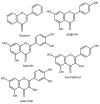The Potential Use of Plant Natural Products and Plant Extracts with Antioxidant Properties for the Prevention/Treatment of Neurodegenerative Diseases: In Vitro, In Vivo and Clinical Trials
- PMID: 30544977
- PMCID: PMC6321248
- DOI: 10.3390/molecules23123283
The Potential Use of Plant Natural Products and Plant Extracts with Antioxidant Properties for the Prevention/Treatment of Neurodegenerative Diseases: In Vitro, In Vivo and Clinical Trials
Abstract
Neurodegenerative disorders, including Alzheimer's disease, Parkinson's disease and Huntington's disease, present a major health issue and financial burden for health care systems around the world. The impact of these diseases will further increase over the next decades due to increasing life expectancies. No cure is currently available for the treatment of these conditions; only drugs, which merely alleviate the symptoms. Oxidative stress has long been associated with neurodegeneration, whether as a cause or as part of the downstream results caused by other factors. Thus, the use of antioxidants to counter cellular oxidative stress within the nervous system has been suggested as a potential treatment option for neurological disorders. Over the last decade, significant research has focused on the potential use of natural antioxidants to target oxidative stress. However, clinical trial results have lacked success for the treatment of patients with neurological disorders. The knowledge that natural extracts show other positive molecular activities in addition to antioxidant activity, however, has led to further research of natural extracts for their potential use as prevention or treatment/management of neurodegenerative diseases. This review will cover several in vitro and in vivo research studies, as well as clinical trials, and highlight the potential of natural antioxidants.
Keywords: Ginkgo biloba; antioxidants; clinical trials; in vitro; in vivo; natural products; phenolics; phytochemicals; plant extracts; secondary metabolites.
Conflict of interest statement
The authors declare no conflict of interest.
Figures


















Similar articles
-
Ginkgo biloba and neurodegenerative disorders.Front Biosci. 2004 Sep 1;9:3091-104. doi: 10.2741/1462. Front Biosci. 2004. PMID: 15353340 Review.
-
Multiple antioxidants in the prevention and treatment of neurodegenerative disease: analysis of biologic rationale.Curr Opin Neurol. 1999 Dec;12(6):761-70. doi: 10.1097/00019052-199912000-00017. Curr Opin Neurol. 1999. PMID: 10676761 Review.
-
Lutein and the Underlying Neuroprotective Promise against Neurodegenerative Diseases.Mol Nutr Food Res. 2024 Jul;68(13):e2300409. doi: 10.1002/mnfr.202300409. Epub 2024 Mar 15. Mol Nutr Food Res. 2024. PMID: 38487969 Review.
-
Neuroprotective Potential and Underlying Pharmacological Mechanism of Carvacrol for Alzheimer's and Parkinson's Diseases.Curr Neuropharmacol. 2023;21(6):1421-1432. doi: 10.2174/1570159X21666221223120251. Curr Neuropharmacol. 2023. PMID: 36567278 Free PMC article. Review.
-
Emerging role of polyphenolic compounds in the treatment of neurodegenerative diseases: a review of their intracellular targets.Eur J Pharmacol. 2006 Sep 1;545(1):51-64. doi: 10.1016/j.ejphar.2006.06.025. Epub 2006 Jun 17. Eur J Pharmacol. 2006. PMID: 16904103 Review.
Cited by
-
Multiple neuroprotective features of Scutellaria pinnatifida-derived small molecule.Heliyon. 2020 Aug 28;6(8):e04737. doi: 10.1016/j.heliyon.2020.e04737. eCollection 2020 Aug. Heliyon. 2020. PMID: 32913905 Free PMC article.
-
Cynanoside F Controls Skin Inflammation by Suppressing Mitogen-Activated Protein Kinase Activation.Antioxidants (Basel). 2022 Sep 1;11(9):1740. doi: 10.3390/antiox11091740. Antioxidants (Basel). 2022. PMID: 36139814 Free PMC article.
-
Identification of Novel Putative Bacterial Feruloyl Esterases From Anaerobic Ecosystems by Use of Whole-Genome Shotgun Metagenomics and Genome Binning.Front Microbiol. 2019 Nov 20;10:2673. doi: 10.3389/fmicb.2019.02673. eCollection 2019. Front Microbiol. 2019. PMID: 31824458 Free PMC article.
-
Thymol protects against 6-hydroxydopamine-induced neurotoxicity in in vivo and in vitro model of Parkinson's disease via inhibiting oxidative stress.BMC Complement Med Ther. 2022 Feb 10;22(1):40. doi: 10.1186/s12906-022-03524-1. BMC Complement Med Ther. 2022. PMID: 35144603 Free PMC article.
-
Current Advances of Plant-Based Vaccines for Neurodegenerative Diseases.Pharmaceutics. 2023 Feb 20;15(2):711. doi: 10.3390/pharmaceutics15020711. Pharmaceutics. 2023. PMID: 36840033 Free PMC article. Review.
References
-
- Prince M., Guerchet M., Prina M. World Alzheimer Report 2013. Alzheimer’s Disease International; London, UK: 2013.
-
- Dorsey E.R., Constantinescu R., Thompson J.P., Biglan K.M., Holloway R.G., Kieburtz K., Marshall F.J., Ravina B.M., Schifitto G., Siderowf A., et al. Projected number of people with Parkinson disease in the most populous nations, 2005 through 2030. Neurology. 2007;68:384–386. doi: 10.1212/01.wnl.0000247740.47667.03. - DOI - PubMed
Publication types
MeSH terms
Substances
Grants and funding
LinkOut - more resources
Full Text Sources
Medical
Molecular Biology Databases

